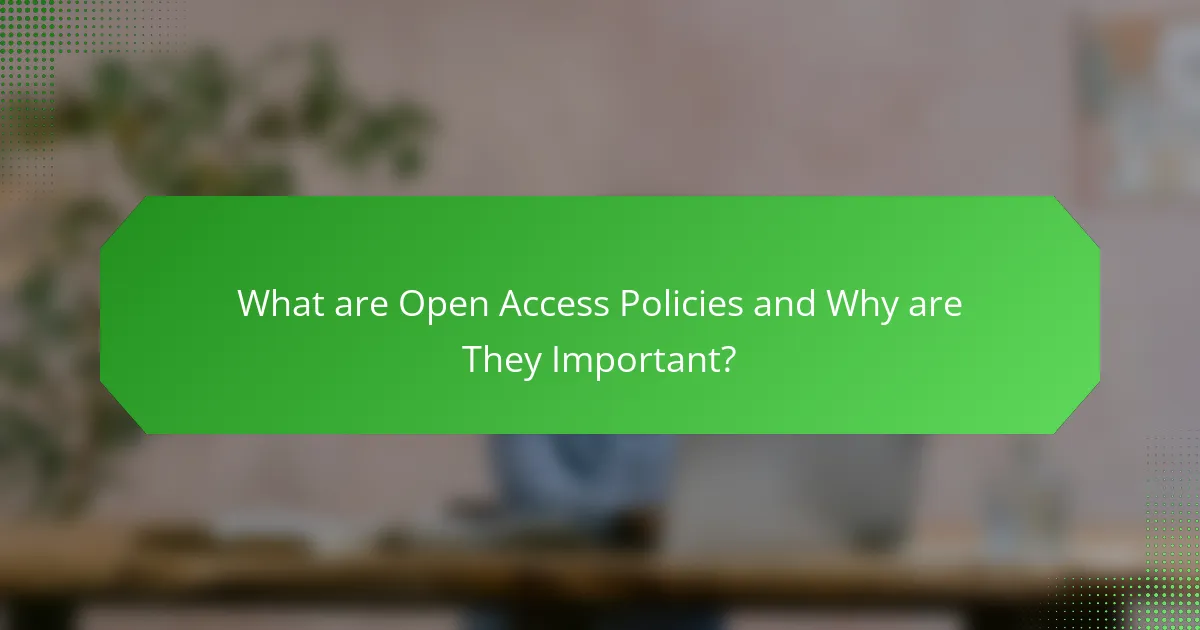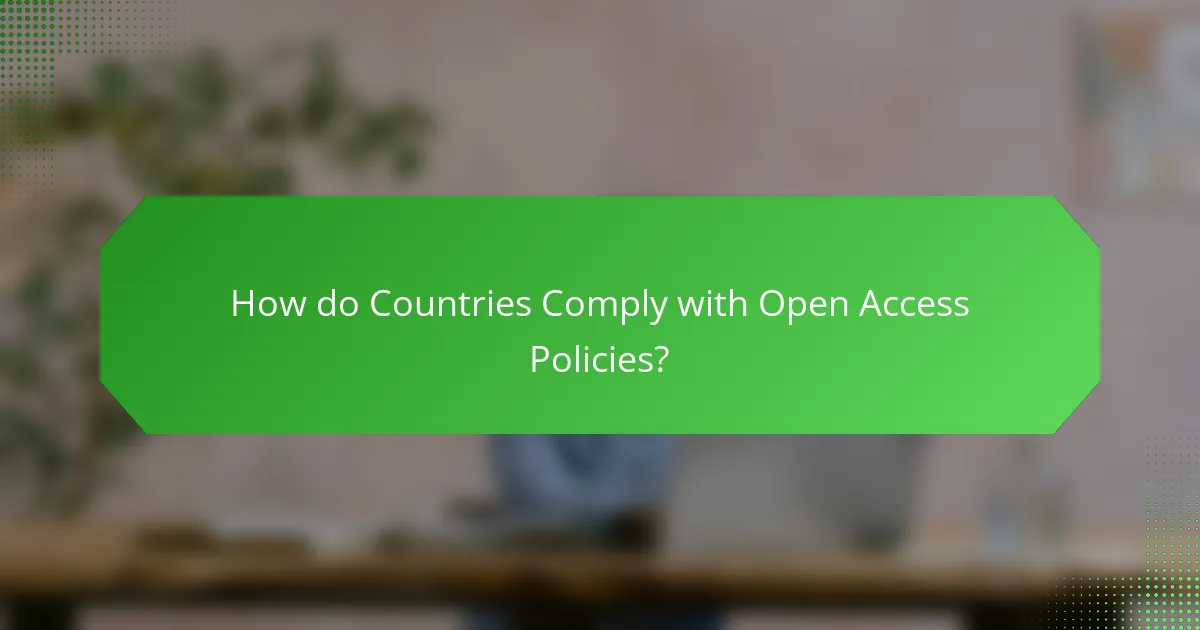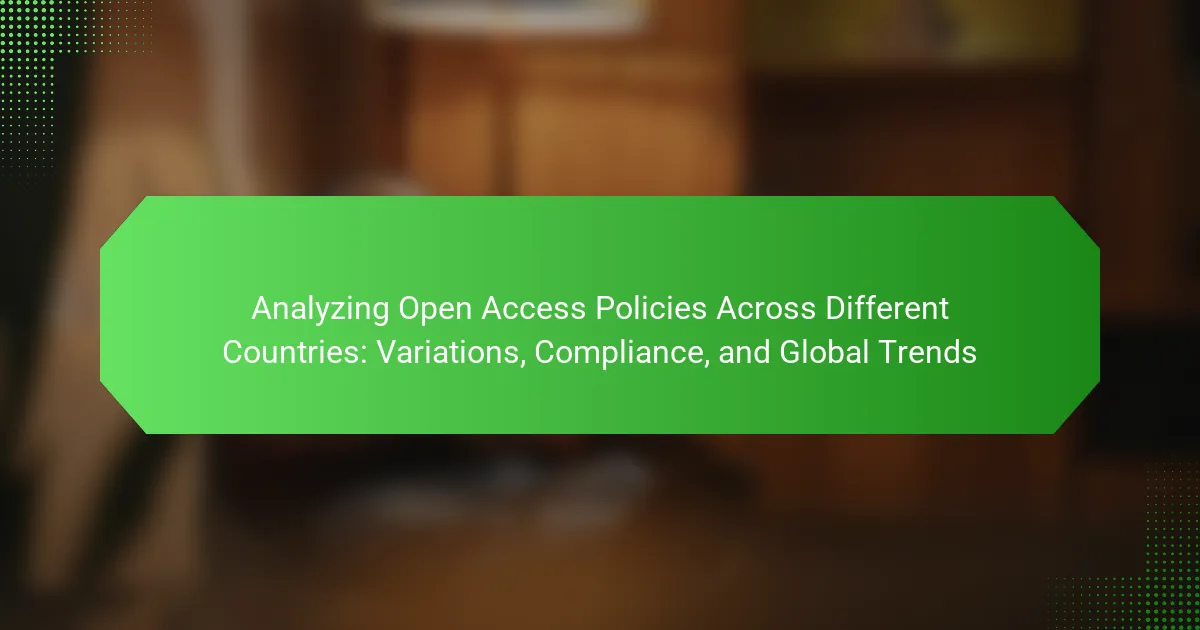Open Access Policies are guidelines designed to facilitate free access to research outputs, promoting the sharing of knowledge and enhancing collaboration among researchers. These policies are crucial for increasing the visibility and impact of scholarly work, leading to higher citation rates and broader dissemination of findings. Countries implement compliance through national mandates and institutional policies, often requiring publicly funded research to be made freely accessible. Global trends indicate a shift towards greater transparency and accessibility, with initiatives like the European Union’s Horizon 2020 program and the U.S. directive for public access to federally funded research driving the adoption of open access standards worldwide. This article analyzes the variations in open access policies across different countries, their compliance mechanisms, and the overarching trends shaping the future of research accessibility.

What are Open Access Policies and Why are They Important?
Open Access Policies are guidelines that promote free access to research outputs. They aim to make scholarly work available to everyone without financial barriers. These policies encourage the sharing of knowledge and foster collaboration among researchers. They are important because they enhance the visibility and impact of research. Increased accessibility can lead to higher citation rates and wider dissemination of findings. Open Access Policies also support public engagement with research. They contribute to the democratization of knowledge by allowing anyone to access valuable information. Many institutions and governments adopt these policies to promote transparency and innovation in research.
How do Open Access Policies vary across different countries?
Open Access Policies vary significantly across different countries. In the United States, policies are often driven by funding agencies like the National Institutes of Health, which mandates public access to research funded by them. In contrast, European countries, particularly those in the EU, have more stringent regulations, with the European Commission pushing for open access through initiatives like Horizon Europe. Countries like Germany and the UK have established national frameworks to promote open access, emphasizing compliance with specific licensing agreements.
Meanwhile, countries in the Global South may have less formalized policies. For instance, Brazil has developed a national open access policy, but implementation varies by institution. In contrast, India has emerging policies that encourage open access, though they are not yet as robust as those in developed nations. Overall, the variation in Open Access Policies reflects differing national priorities, funding structures, and institutional capabilities.
What factors influence the formulation of Open Access Policies in various nations?
The formulation of Open Access Policies in various nations is influenced by several key factors. These factors include government regulations and mandates that promote accessibility to publicly funded research. Institutional policies from universities and research organizations also play a crucial role in shaping these policies. Additionally, the cultural attitudes towards open access and scholarly communication impact the development of these policies. Economic considerations, such as funding availability for open access initiatives, further influence policy formulation. The level of collaboration among stakeholders, including researchers, publishers, and policymakers, is essential for effective policy implementation. Lastly, international agreements and frameworks, like the Budapest Open Access Initiative, guide national policies towards open access.
How do cultural and economic contexts shape Open Access Policies?
Cultural and economic contexts significantly influence Open Access Policies. Cultural attitudes towards knowledge sharing affect the acceptance of open access in different regions. For example, countries with strong traditions of communal knowledge, like many in Scandinavia, often embrace open access more readily. Economic factors also play a crucial role. Nations with robust funding for research are more likely to implement open access policies. According to a study by the European Commission, countries investing heavily in research and development, such as Germany and the UK, show higher compliance with open access mandates. Conversely, developing nations may struggle to adopt these policies due to limited funding and infrastructure. These contexts create a diverse landscape for open access, shaping how policies are formed and implemented globally.
What are the key components of Open Access Policies?
Key components of Open Access Policies include definitions of open access, licensing requirements, and compliance mechanisms. Open access is defined as unrestricted online access to research outputs. Licensing requirements typically specify the use of Creative Commons licenses. Compliance mechanisms ensure adherence to the policy by authors and institutions. Funding mandates often require publicly funded research to be openly accessible. These policies may include provisions for repositories where research outputs are deposited. Monitoring and reporting processes are also essential for assessing policy effectiveness. These components collectively promote transparency and accessibility in scholarly communication.
What types of Open Access models exist?
There are several types of Open Access models. The primary models are Gold, Green, and Hybrid Open Access. Gold Open Access involves publishing articles in journals that provide immediate free access to all content. Green Open Access allows authors to self-archive their work in repositories, making it accessible after an embargo period. Hybrid Open Access combines subscription-based content with the option for authors to pay for their articles to be openly accessible. Each model has distinct characteristics regarding access, funding, and publication practices. These models reflect varying approaches to disseminating research while ensuring accessibility.
How do funding and publication fees impact Open Access Policies?
Funding and publication fees significantly influence Open Access (OA) policies. These financial aspects determine the accessibility of research output. Funding bodies often mandate that research funded by them must be published in OA formats. This requirement can lead to an increase in the number of OA publications. Publication fees can act as a barrier for some researchers, especially in developing countries. High fees may limit the participation of researchers without adequate funding. Consequently, this creates disparities in OA publishing across different regions. Studies show that countries with dedicated OA funding exhibit higher compliance rates with OA policies. For example, the UK’s Research Excellence Framework encourages OA through financial support. Thus, funding and publication fees directly shape the landscape of Open Access policies globally.

How do Countries Comply with Open Access Policies?
Countries comply with open access policies by implementing national mandates and funding requirements. These mandates often require publicly funded research to be made freely accessible. Many countries establish repositories for storing and sharing research outputs. Compliance is also achieved through institutional policies that support open access publishing. Some nations provide financial incentives for researchers to publish in open access journals. Additionally, international collaborations promote adherence to open access standards. Data shows that countries with strong open access policies see increased visibility and citation of their research. For instance, the European Union’s Horizon 2020 program mandates open access to research outputs, reinforcing compliance across member states.
What mechanisms are in place to ensure compliance with Open Access Policies?
Compliance with Open Access Policies is ensured through several mechanisms. These include institutional mandates, funding agency requirements, and legal frameworks. Institutional mandates require researchers to deposit their work in designated repositories. Funding agencies often condition grants on adherence to Open Access requirements. Legal frameworks can enforce compliance through copyright and licensing agreements. Additionally, monitoring and reporting systems track adherence to these policies. Some countries implement penalties for non-compliance to reinforce these mechanisms. These strategies collectively promote transparency and accessibility in research dissemination.
How do institutions monitor adherence to Open Access mandates?
Institutions monitor adherence to Open Access mandates through several methods. They often require researchers to submit reports detailing their compliance with Open Access policies. Many institutions utilize repositories to track published works and ensure they are accessible. They may also conduct audits of research outputs to verify adherence. Compliance metrics can include the percentage of publications available in Open Access formats. Some institutions collaborate with funders to align reporting requirements. Additionally, institutions may implement software tools to analyze publication data. These methods help ensure that researchers meet Open Access obligations efficiently.
What role do government regulations play in compliance efforts?
Government regulations establish the framework for compliance efforts across various sectors. They define the standards and requirements that organizations must adhere to. These regulations ensure accountability and transparency in operations. Compliance efforts are often driven by the need to meet these legal obligations. For example, the implementation of the General Data Protection Regulation (GDPR) in the European Union has significantly influenced data handling practices. Organizations must invest in systems and processes to align with such regulations. Failure to comply can result in severe penalties, which further motivates adherence. Thus, government regulations play a crucial role in shaping compliance strategies and practices.
What challenges do countries face in enforcing Open Access Policies?
Countries face several challenges in enforcing Open Access Policies. One major challenge is the lack of funding for open access initiatives. Many countries struggle to allocate sufficient resources to support these policies. Another issue is the varying levels of infrastructure among countries. Some nations lack the necessary technological capabilities to implement open access effectively. Additionally, there are legal and regulatory barriers that complicate enforcement. Intellectual property rights often conflict with open access principles. Resistance from traditional publishing models also poses a significant challenge. Established publishers may oppose policies that threaten their revenue. Lastly, there is a lack of awareness and understanding of open access among researchers and institutions. This knowledge gap can hinder compliance and implementation efforts.
How do technological barriers affect compliance with Open Access?
Technological barriers significantly hinder compliance with Open Access. Limited internet access restricts researchers in low-income regions from accessing and sharing resources. Insufficient digital infrastructure can lead to difficulties in uploading and managing research outputs. Compatibility issues with various platforms may prevent effective dissemination of Open Access materials. Additionally, lack of technical skills among researchers can impede their ability to navigate Open Access systems. According to a study by the International Federation of Library Associations, 40% of researchers in developing countries cite technology as a primary obstacle to Open Access compliance. This highlights the critical role technology plays in enabling or restricting Open Access participation.
What are the common misconceptions about Open Access compliance?
Common misconceptions about Open Access compliance include the belief that it is only for publicly funded research. Many assume that Open Access applies solely to specific disciplines, neglecting its presence across various fields. Another misconception is that Open Access means free for all without any restrictions, while many journals have specific licensing agreements. Some think compliance is optional, but it is often mandated by funding agencies and institutions. Additionally, there is a belief that Open Access publishing is always more expensive, while many options are cost-effective or free. Lastly, some researchers believe that Open Access reduces the quality of research, despite studies showing that it can enhance visibility and citation rates.

What are the Global Trends in Open Access Policies?
Global trends in open access policies include increased mandates for public access to research outputs. Many countries are adopting policies that require publicly funded research to be openly accessible. The European Union has set ambitious targets for open access through initiatives like Horizon Europe. In the United States, the White House Office of Science and Technology Policy issued a directive for public access to federally funded research. Additionally, many institutions are establishing their own open access repositories. The rise of Plan S in Europe aims to accelerate the transition to open access publishing. These trends indicate a global shift towards transparency and accessibility in research.
How are international collaborations influencing Open Access Policies?
International collaborations are significantly shaping Open Access Policies. These partnerships encourage the sharing of research outputs globally. They often lead to the establishment of common standards and practices. For example, initiatives like Plan S promote immediate Open Access to publicly funded research. Countries involved in such collaborations adopt similar policies to align with international norms. This alignment facilitates greater accessibility and visibility of research. Additionally, joint funding programs often require Open Access compliance. As a result, researchers are incentivized to publish in Open Access formats. The influence of international collaborations is evident in the increasing number of countries adopting Open Access mandates.
What impact do global initiatives have on national Open Access strategies?
Global initiatives significantly influence national Open Access strategies by providing frameworks and guidelines. These initiatives, such as the Plan S and the UNESCO Open Access Recommendation, promote transparency and accessibility in research. They encourage countries to adopt policies that align with international standards. This alignment can lead to increased funding for Open Access projects. Additionally, global initiatives foster collaboration among nations, enhancing the sharing of resources and knowledge. They also raise awareness of the importance of Open Access, prompting governments to prioritize it in their agendas. As a result, national strategies often reflect the objectives set by these global movements.
How do trends in Open Access reflect broader shifts in scholarly communication?
Trends in Open Access reflect broader shifts in scholarly communication by promoting transparency and accessibility. Open Access enables researchers to share their findings without paywalls. This shift aligns with the increasing demand for public access to research. Studies show that Open Access articles receive more citations, indicating a change in how research impact is measured. Additionally, funding agencies now mandate Open Access for grant recipients, further embedding it in scholarly practices. The rise of preprint servers exemplifies rapid dissemination of research, challenging traditional publication timelines. Overall, Open Access is reshaping the landscape of academic publishing and collaboration.
What future developments can we expect in Open Access Policies?
Future developments in Open Access Policies will likely include increased mandates for public access to research funded by government grants. Many countries are moving towards implementing national policies that require open access to publicly funded research. This trend is supported by initiatives such as Plan S, which aims to ensure that publicly funded research is published in compliant open access journals. Additionally, we may see the emergence of more standardized policies across institutions and countries to streamline compliance and accessibility. The European Union’s Horizon Europe program emphasizes open science and mandates open access to research outputs. As a result, increased collaboration among stakeholders, including publishers and researchers, is expected to enhance the effectiveness of these policies.
How might emerging technologies reshape Open Access landscapes?
Emerging technologies will reshape Open Access landscapes by enhancing accessibility and streamlining publication processes. Technologies such as blockchain can provide transparent and secure methods for sharing research outputs. Artificial Intelligence (AI) can automate the peer review process, increasing efficiency and reducing publication times. Machine learning algorithms can also help in discovering relevant research, making it easier for users to find open access materials. Furthermore, data analytics can track usage patterns and improve content delivery. These advancements may lead to a more equitable distribution of knowledge globally. According to a 2021 report by the European Commission, the adoption of these technologies can significantly increase the reach and impact of open access publications.
What role will advocacy groups play in the evolution of Open Access Policies?
Advocacy groups will play a crucial role in the evolution of Open Access Policies. These organizations will push for transparency and accessibility in research outputs. They will influence policymakers to adopt more inclusive practices. Advocacy groups will also raise awareness about the benefits of Open Access for researchers and the public. Their efforts can lead to increased funding for Open Access initiatives. Additionally, they will collaborate with academic institutions to promote best practices. Studies show that advocacy efforts have historically led to significant policy changes. For example, the SPARC organization has successfully influenced Open Access policies in multiple countries.
What best practices should countries adopt for effective Open Access Policies?
Countries should adopt clear guidelines for Open Access Policies. These guidelines should define the scope of open access. They must include mandates for publicly funded research. Transparency in funding and publication processes is essential. Countries should ensure compliance through monitoring and reporting mechanisms. Collaboration with stakeholders, including researchers and publishers, is crucial. Implementing support systems for researchers enhances policy effectiveness. Providing education on open access benefits increases awareness and adoption.
The main entity of this article is Open Access Policies, which are guidelines that promote free access to research outputs, enhancing visibility and engagement in scholarly work. The article analyzes variations in Open Access Policies across different countries, highlighting the influence of government regulations, cultural attitudes, and economic factors on their formulation and compliance. It discusses key components of these policies, the challenges faced in their enforcement, and the impact of global initiatives on national strategies. Additionally, the article explores future developments in Open Access, including the role of emerging technologies and advocacy groups in shaping these policies.


